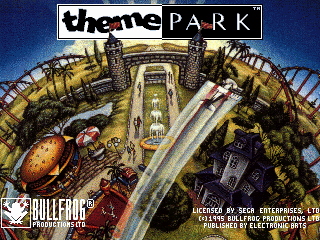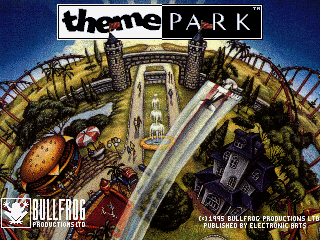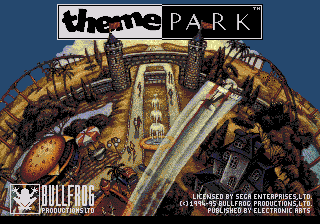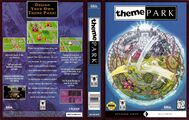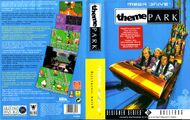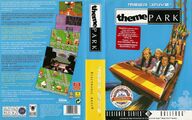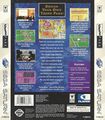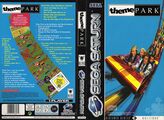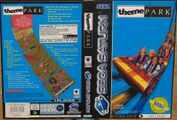Theme Park
From Sega Retro
| Theme Park | |||||||||||||||||||||||||||||||||||||||||||||||||||||||||||||||||||||||||||||||||||||||||||||||
|---|---|---|---|---|---|---|---|---|---|---|---|---|---|---|---|---|---|---|---|---|---|---|---|---|---|---|---|---|---|---|---|---|---|---|---|---|---|---|---|---|---|---|---|---|---|---|---|---|---|---|---|---|---|---|---|---|---|---|---|---|---|---|---|---|---|---|---|---|---|---|---|---|---|---|---|---|---|---|---|---|---|---|---|---|---|---|---|---|---|---|---|---|---|---|---|
| System(s): Sega Mega Drive, Sega Mega-CD, Sega Saturn | |||||||||||||||||||||||||||||||||||||||||||||||||||||||||||||||||||||||||||||||||||||||||||||||
| Publisher: Electronic Arts (US/EU) Domark Electronic Arts Victor (JP) | |||||||||||||||||||||||||||||||||||||||||||||||||||||||||||||||||||||||||||||||||||||||||||||||
| Developer: Bullfrog Productions Krisalis Software | |||||||||||||||||||||||||||||||||||||||||||||||||||||||||||||||||||||||||||||||||||||||||||||||
| Supporting companies: Interactive Studios (FMVs) | |||||||||||||||||||||||||||||||||||||||||||||||||||||||||||||||||||||||||||||||||||||||||||||||
| Distributor: SF Interactive Media (SE rental) Electronic Arts Australasia (AU) Acclaim Entertainment (EU) | |||||||||||||||||||||||||||||||||||||||||||||||||||||||||||||||||||||||||||||||||||||||||||||||
| Sound driver: Images Software/Russel Shaw SCSP/CD-DA (20 tracks) | |||||||||||||||||||||||||||||||||||||||||||||||||||||||||||||||||||||||||||||||||||||||||||||||
| Genre: Simulation[1][2] | |||||||||||||||||||||||||||||||||||||||||||||||||||||||||||||||||||||||||||||||||||||||||||||||
| Number of players: 1 | |||||||||||||||||||||||||||||||||||||||||||||||||||||||||||||||||||||||||||||||||||||||||||||||
| Official in-game languages: | |||||||||||||||||||||||||||||||||||||||||||||||||||||||||||||||||||||||||||||||||||||||||||||||
| |||||||||||||||||||||||||||||||||||||||||||||||||||||||||||||||||||||||||||||||||||||||||||||||
|
Theme Park (テーマパーク) is a management simulator developed by Bullfrog Productions and published by Electronic Arts in 1994. It was released for a variety of systems, including the Sega Mega Drive, Sega Mega-CD, Sega Saturn in the following year.
From a Sega perspective the game is fairly interesting, as it technically released twice on the Saturn in Japan, first as regular Theme Park seen here, and again as Shin Theme Park, a localised variant. The game was originally designed with a mouse in mind, but none of the Sega ports are compatible with their respective mouse add ons, whether that be the Sega Mouse or Shuttle Mouse.
Contents
Gameplay
Theme Park was the first successful theme park simulator, and would go on to inspire other Theme games and the RollerCoaster Tycoon series. Players are given a plot of land and are tasked with buying (and creating) rides, as well as organising the general layout of the park, staff and attempting to keep visitors happy without going bankrupt.
Rides
All versions
| Monorail | |
|---|---|
| Bouncy Castle | |
| Tree House | |
| Merry-Go-Round | |
| Rubber Tubing | |
| Maze | |
| Roller Coaster | |
| Super Spinner | |
| Observatory | |
| Ghost House | |
| Plane Flyer | |
| Big Wheel | |
| Observation Tower/High Tower | |
| Pirate Boat | |
| Flight Sim | |
| Haunted House/Spooky House | |
Mega Drive/Mega-CD exclusive
| Barn Dance | |
|---|---|
| Worm Hole | |
| Clown Ride | |
| Speedway | |
| Band | |
| Buzzy Bee | |
| Octopus | |
| Subride | |
| Magic Carpet | |
| Dolphin Acts | |
Saturn exclusive
These rides aren't in the 16-bit versions, but were in the original IBM PC version, as well as the Saturn.
| Snakes and Ladders | |
|---|---|
| Planet Rocket | |
| Clown Acts | |
| Parasol Chairs | |
| Race Car Ride | |
| Cowboy Acts | |
| Space Shuttle | |
| Loop the Loop | |
| Corkscrew | |
Shops
| Coffee Shop | |
|---|---|
| Balloon World | |
| Mr. Wally Ices | |
| Big Time Fries | |
| Pokey Cola | |
| Duck Shoot/Hook a Duck | |
| Big Time Burger | |
| Novelty Shop | |
| Saloon | |
| Gun Shoot | |
| Tin Can Alley/Duck Shoot | |
| Steak Restaurant/Toy Land | |
| Coconut Shy | |
| Race Track | |
| Arcade | |
Features
| Birch Tree | |
|---|---|
| Tree Stump Fence | |
| Lamp Post | |
| White Fence | |
| Orange Tree | |
| Apple Tree | |
| Castle Wall | |
| Not in the 16-bit versions. | |
| Privet Hedge | |
| Not in the 16-bit versions. | |
| Tropical Bush/Tropics Tree | |
| Rose Bush | |
| Weeping Tree | |
| Palm Tree | |
| Spooky Tree | |
| Oak Tree | |
| Not in the 16-bit versions. | |
| Outhouse/Toilet Shed | |
| Lake | |
| Boggy Crapper/Out House | |
| Super Toilet | |
| Centre Fountain | |
Staff
While the Saturn version has five different types of entertainer, the 16-bit versions condense it into one, who looks like a clown.
| Teddy Man | |
|---|---|
| Shark Man | |
| Handyman | |
| Chicken Man | |
| Strong Man | |
| Mechanic | |
| Rhino Man | |
| Guard | |
History
Legacy
Theme Park would later see a true sequel in the form of the fully 3D Theme Park World (known as Sim Theme Park in North America) in 1999.
Versions
Mega Drive version
The Mega Drive version of Theme Park is stripped back from the IBM PC original, partly due to cartridge space but also a decision to simplify and speed up gameplay. Low level management aspects such as buying shares in rival parks and ordering replacement stock for shops was omitted for the latter reason[12]. In addition, the user no longer has to set patrol zones for staff, with a new AI routine causing them to actively seek out broken rides or rubbish. Rides are also more durable, and are less likely to explode and destroy parts of the park.
Many of the samples were cut, though roughly 300kB of the ROM is still devoted to sound[13]. The Mega Drive port also adds more rides, bringing the total number to 27. Games cannot be saved in the Mega Drive version, meaning all progress is lost of the console is turned off or reset.
One trick used in the Mega Drive version to save space was to draw most of the in-game graphics "flat", shifting pixels at runtime to give the illusion of an oblique camera perspective[12]. Snow and desert stages, not seen in the computer versions, were created by changing the palette of the grass[13]. The adviser also only appears when needed, rather than being a permanent feature of the HUD.
Mega-CD version
Theme Park on the Mega-CD derives from its Mega Drive incarnation, with an added CD soundtrack and re-introduced full motion video clips. There is still no saving on the Mega-CD - while the idea was discussed, it was ruled out as saves would have required several megabytes - far bigger than what was available with the CD BackUp RAM Cart[14].
Production credits
Mega-CD version
- Designed by: Bullfrog Productions Ltd.
- FMV Implementation: Interactive Studios
- Original Sega Programming: Andy Beale
- Original Sega Producer: Mark Webley
- Original Sega Graphics: Paul McLaughlin, Chris Hill, Fin McGechie, Mark Healey
- Original Version: Peter Molyneux, Demis Hassabis
- Sound & Music: Russell Shaw
- Sound Implementation: Images Software
- Mega CD Conversion: Jim Blackler
- FMV Implmentation: Images Software
- Product Manager: Mark Gilbert
Saturn version
- Designed by: Bullfrog Productions Ltd.
- Conversion by: Krisalis Software Ltd.
- Programming by: Simeon Pashley
- Original Programming by: Peter Molyneux, Demis Hassabis, Mark Webley, Guy Simmns, Mark Lamport, James Robertson, Mike Diskett
- Graphics and Art Concepts by: Paul McLaughlin, Chris Hill, Fin McGechie, Mike Mann, Mark Healey, Andy Sandham
- Introduction Sequence designed by: Chris Hill
- Sound & Music by: Russell Shaw
- Testing by: Jeff Brutus, Ken Malcolm, Peter Hughes, Robert Byrne, Nick Harper, Matt Sullivan, James Smith
- Management: Les Edgar
- PR & Marketing: Cathy Campos, Sean Ratcliffe
- Documentation: Matt Miles Griffiths
- Documentation Layout: Tom Peters
- Quality Aassurance: Logan Parr
Magazine articles
- Main article: Theme Park/Magazine articles.
Promotional material
- Main article: Theme Park/Promotional material.
Physical scans
Mega Drive version
| Sega Retro Average | ||||||||||||||||||||||||||||||||||||||||||||||||||||||||||||||||||||||||||||||||||||||||||||||||||||||||||||||||||||||||||||
|---|---|---|---|---|---|---|---|---|---|---|---|---|---|---|---|---|---|---|---|---|---|---|---|---|---|---|---|---|---|---|---|---|---|---|---|---|---|---|---|---|---|---|---|---|---|---|---|---|---|---|---|---|---|---|---|---|---|---|---|---|---|---|---|---|---|---|---|---|---|---|---|---|---|---|---|---|---|---|---|---|---|---|---|---|---|---|---|---|---|---|---|---|---|---|---|---|---|---|---|---|---|---|---|---|---|---|---|---|---|---|---|---|---|---|---|---|---|---|---|---|---|---|---|---|
|
| 80 | |
|---|---|
| Based on 24 reviews | |
| Mega Drive, SE (rental; SF) |
|---|
Mega-CD version
| Sega Retro Average | ||||||||||||||||||||||||||||||||||
|---|---|---|---|---|---|---|---|---|---|---|---|---|---|---|---|---|---|---|---|---|---|---|---|---|---|---|---|---|---|---|---|---|---|---|
|
| 86 | |
|---|---|
| Based on 6 reviews | |
| Mega-CD, PT |
|---|
|
Saturn version
| Sega Retro Average | ||||||||||||||||||||||||||||||||||||||||||||||||||||||||||||||||||||||||||||||||||||||||||||||||||||||||||||||||||
|---|---|---|---|---|---|---|---|---|---|---|---|---|---|---|---|---|---|---|---|---|---|---|---|---|---|---|---|---|---|---|---|---|---|---|---|---|---|---|---|---|---|---|---|---|---|---|---|---|---|---|---|---|---|---|---|---|---|---|---|---|---|---|---|---|---|---|---|---|---|---|---|---|---|---|---|---|---|---|---|---|---|---|---|---|---|---|---|---|---|---|---|---|---|---|---|---|---|---|---|---|---|---|---|---|---|---|---|---|---|---|---|---|---|---|
|
| 84 | |
|---|---|
| Based on 22 reviews | |
Technical information
- Main article: Theme Park/Technical information.
References
NEC Retro has more information related to Theme Park
|
- ↑ File:ThemePark Saturn JP Box Back.jpg
- ↑ 2.0 2.1 https://sega.jp/fb/segahard/ss/soft_licensee1.html (Wayback Machine: 2020-03-20 23:04)
- ↑ https://www.youtube.com/watch?v=MERwuwZK9YM (Ghostarchive)
- ↑ 4.0 4.1 4.2 Sega Magazine, "June 1995" (UK; 1995-05-15), page 12
- ↑ 5.0 5.1 Sega Power, "June 1995" (UK; 1995-04-20), page 34
- ↑ Games World Magazin, "" (DE; 1995-0x-xx), page 67
- ↑ Computer Trade Weekly, "" (UK; 1995-08-28), page 20
- ↑ Sega Saturn Magazine, "1995-14 (1995-12-22)" (JP; 1995-12-08), page 26
- ↑ https://groups.google.com/g/rec.games.video.sega/c/T4WkQJmhX1I/m/tnm7n7htwDsJ
- ↑ 10.0 10.1 10.2 Sega Saturn Magazine, "November 1995" (UK; 1995-10-26), page 64
- ↑ Computer Trade Weekly, "" (UK; 1995-11-06), page 36
- ↑ 12.0 12.1 Mean Machines Sega, "November 1994" (UK; 1994-09-30), page 30
- ↑ 13.0 13.1 Mean Machines Sega, "November 1994" (UK; 1994-09-30), page 29
- ↑ Interview: Jim Blackler by Segacollection.com
- ↑ File:ThemeParkMegaCDEUManual.pdf, page 33
- ↑ File:Themepark sat us manual.pdf, page 53
- ↑ 1700 igr dlya Sega, "" (RU; 2001-xx-xx), page 242
- ↑ Consoles +, "Mai 1995" (FR; 1995-0x-xx), page 108
- ↑ Cool Gamer, "9" (RU; 2002-10-13), page 223
- ↑ Digitiser (UK) (1995-06-07)
- ↑ Entsiklopediya luchshikh igr Sega. Vypusk 1, "" (RU; 1999-xx-xx), page 363
- ↑ Entsiklopediya luchshikh igr Sega. Vypusk 3, "" (RU; 2000-xx-xx), page 344
- ↑ Fusion, "Volume 1, Number 4: November 1995" (US; 1995-1x-xx), page 120
- ↑ GamesMaster, "May 1995" (UK; 1995-04-16), page 63
- ↑ Games World: The Magazine, "June 1995" (UK; 1995-0x-xx), page 72
- ↑ Joypad, "Avril 1995" (FR; 1995-0x-xx), page 91
- ↑ MAN!AC, "05/95" (DE; 1995-04-12), page 65
- ↑ Mega, "June 1995" (UK; 1995-05-31), page 16
- ↑ Mega Fun, "06/95" (DE; 1995-05-24), page 68
- ↑ Mean Machines Sega, "May 1995" (UK; 1995-03-28), page 18
- ↑ Player One, "Mai 1995" (FR; 1995-0x-xx), page 70
- ↑ Power Unlimited, "Jaagang 3, Jul/Aug 1995" (NL; 1995-06-28), page 30
- ↑ Sega Magazin, "Dezember 1995" (DE; 1995-11-15), page 54
- ↑ Sega News, "Leden 1997" (CZ; 1997-xx-xx), page 27
- ↑ Sega Pro, "May 1995" (UK; 1995-04-13), page 78
- ↑ Todo Sega, "Mayo 1995" (ES; 1995-0x-xx), page 32
- ↑ Top Consoles, "Mai 1995" (FR; 1995-0x-xx), page 112
- ↑ Tricks 16 bit, "Tricks Sega Gold 800 igr" (RU; 1998-03-20), page 26
- ↑ Video Games, "10/95" (DE; 1995-09-27), page 78
- ↑ MAN!AC, "01/96" (DE; 1995-12-06), page 71
- ↑ Player One, "Juillet/Août 1995" (FR; 1995-0x-xx), page 114
- ↑ Player One, "Novembre 1995" (FR; 1995-1x-xx), page 140
- ↑ Sega Magazine, "July 1995" (UK; 1995-06-15), page 86
- ↑ Sega Power, "August 1995" (UK; 1995-06-15), page 46
- ↑ Video Games, "10/95" (DE; 1995-09-27), page 106
- ↑ Consoles +, "Novembre 1995" (FR; 1995-1x-xx), page 170
- ↑ Electronic Gaming Monthly, "January 1996" (US; 199x-xx-xx), page 40
- ↑ Famitsu, "1995-12-29" (JP; 1995-12-15), page 1
- ↑ Fun Generation, "06/95" (DE; 1995-0x-xx), page 84
- ↑ GamePro, "November 1995" (DE; 1995-10-04), page 74
- ↑ GamePro, "March 1996" (UK; 1996-01-25), page 28
- ↑ Gamers, "Dezember 1995" (DE; 1995-11-08), page 61
- ↑ Game Informer, "December 1995" (US; 1995-1x-xx), page 47
- ↑ Hobby Consolas, "Enero 1996" (ES; 199x-xx-xx), page 104
- ↑ MAN!AC, "11/95" (DE; 1995-10-11), page 56
- ↑ Mega Fun, "01/96" (DE; 1995-12-20), page 72
- ↑ Mean Machines Sega, "November 1995" (UK; 1995-09-29), page 66
- ↑ Player One, "Novembre 1995" (FR; 1995-1x-xx), page 120
- ↑ Saturn Fan, "1996 No. 5" (JP; 1996-02-16), page 68
- ↑ Saturn+, "Easter/April 1996" (UK; 1996-03-07), page 59
- ↑ Sega News, "Leden 1997" (CZ; 1997-xx-xx), page 25
- ↑ Sega Power, "December 1995" (UK; 1995-10-19), page 60
- ↑ Sega Pro, "November 1995" (UK; 1995-10-05), page 38
- ↑ Sega Saturn Magazine, "1995-14 (1995-12-22)" (JP; 1995-12-08), page 204
- ↑ Sega Saturn Magazine, "Readers rating final data" (JP; 2000-03), page 15
- ↑ Total Saturn, "Volume One Issue Four" (UK; 1996-12-29), page 57
| Theme Park | |
|---|---|
|
Main page | Comparisons | Hidden content | Magazine articles | Video coverage | Reception | Promotional material | Region coding | Technical information | Bootlegs | |
- 1 player games
- US Mega Drive games
- All US games
- US Sega Channel games
- EU Mega Drive games
- All EU games
- DE Mega Drive games
- All DE games
- UK Mega Drive games
- All UK games
- SE Mega Drive games
- All SE games
- AU Mega Drive games
- All AU games
- CA Mega Drive games
- All CA games
- CA Sega Channel games
- Mega Drive games
- 1995 Mega Drive games
- All 1995 games
- Mega Drive simulation games
- All simulation games
- EU Mega-CD games
- PT Mega-CD games
- All PT games
- UK Mega-CD games
- Mega-CD games
- 1995 Mega-CD games
- Mega-CD simulation games
- JP Saturn games
- All JP games
- US Saturn games
- EU Saturn games
- DE Saturn games
- PT Saturn games
- UK Saturn games
- PL Saturn games
- All PL games
- Saturn games
- 1995 Saturn games
- Saturn simulation games
- All games
- Old-style rating (cvg)
- Update ratings template
- 1 old ratings
- Old-style rating (digitiser)
- 0 old ratings
- Theme Park
- Sega Channel games
